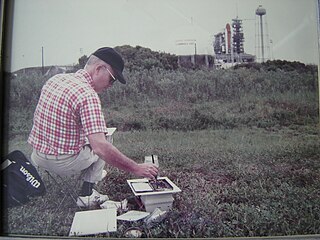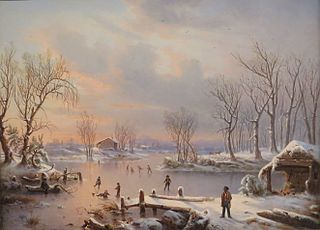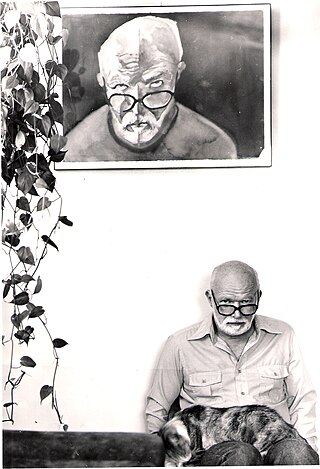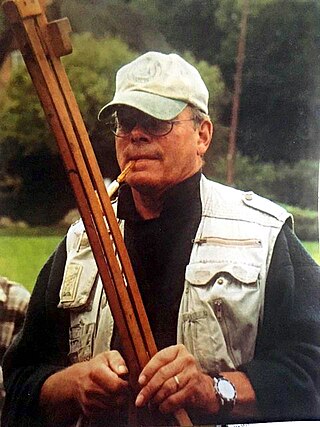Thomas Aquinas Daly (b. 1937) is an American contemporary landscape and still life painter.
Daly was born March 27, 1937 in Niagara Falls, New York, and graduated from Bishop Duffy High School (now Niagara Catholic High School) in 1955. Educated as a graphic artist at the University at Buffalo, Daly spent 23 years working in the commercial printing business before leaving it in 1981 to devote his full attention to painting.
Daly's work has been displayed in numerous solo exhibitions at galleries, museums and universities throughout the country. President Gerald R. Ford recognized Daly's talent by awarding him Grand Central Art Galleries' Gold Medal at the opening of his 1987 show in New York. [1] In addition to painting, Daly has produced two books: Painting Nature's Quiet Places (Watson-Guptill, 1985) and The Art of Thomas Aquinas Daly: The Painting Season (1998).
His paintings have also appeared in several other publications, among them: The Ultimate Fishing Book, The Sweet of the Year, The Sporting Life, Atlantic Salmon Chronicles and The Art of Shooting Flying. Additionally his work has been featured in periodicals such as Gray's Sporting Journal, Arts Magazine, American Artist, Sports Afield, Sporting Classics, Wildlife Art News, Southwest Art, Western Art & Architecture, and Watercolor.
In 2021, Daly was awarded the Red Smith Award from the National Museum of Wildlife Art in Jackson Hole, Wyoming. [2]

Emile Albert Gruppé (1896–1978) was an American painter, known for impressionistic landscapes and Massachusetts coastal and marine paintings.

Philip Jamison was an American artist working primarily with watercolor as a medium. Typical scenes are landscapes, seascapes, interiors and flower arrangements.

Robert Beverly Hale was an artist, curator of American paintings at the Metropolitan Museum of Art, and instructor of artistic anatomy at the Art Students League of New York and the Pennsylvania Academy of Fine Art. He was also the author of the well-known book Drawing Lessons from the Great Masters, as well as the translator of the classic anatomy text Artistic Anatomy by Dr. Paul Richer.
Classical Realism is an artistic movement in the late-20th and early 21st century in which drawing and painting place a high value upon skill and beauty, combining elements of 19th-century neoclassicism and realism.
Altoon Sultan (1948) is an American artist and author who specializes in rural landscapes painted in egg tempera. Her works are in the collections of the Metropolitan Museum of Art, the Museum of Fine Arts, Boston, and the Yale University Art Gallery. She has received two grants from the National Endowment for the Arts. She received her BFA in 1969 after studying painting at Brooklyn College, and her MFA in 1971, also at Brooklyn College, where she studied with Philip Pearlstein and Lois Dodd. She also attended Skowhegan School of Painting and Sculpture.
Robert Remsen Vickrey was a Massachusetts-based artist and author who specialized in the ancient medium of egg tempera. His paintings are surreal dreamlike visions of sunset shadows of bicycles, nuns in front of mural-painted brick walls, and children playing.

Régis François Gignoux (1814–1882) was a French painter who was active in the United States from 1840 to 1870.
Melanie Ann (Huckaby) Fain, is a printmaker specializing in wildlife art. The Texas artist is best known for her etchings and watercolors featuring birds, botanicals, insects, and sporting themes.
Madison Fred Mitchell belonged to the New York School Abstract Expressionist artists whose influence and artistic innovation by the 1950s had been recognized around the world. New York School Abstract Expressionism, represented by Jackson Pollock, Willem de Kooning, Franz Kline and others became a leading art movement of the post-World War II era.
Maynard Fred Reece was an American artist based in Iowa whose work focused on wildlife, particularly ducks. He won the Federal Duck Stamp competition a record five times in his life: 1948, 1951, 1959, 1969 and 1971. Reece turned 100 in April 2020 and died in July that year.

Floyd MacMillan Davis was an American painter and illustrator known for his work in advertising and illustration; Walter and Roger Reed described him as "someone who could capture the rich, beautiful people of the 1920s: dashing, mustachioed men; the cool, svelte women. But Davis was just as capable at capturing just-plain-folk, and with a cartoonist's sensibilities and a fresh humor, he expanded into story art and ad work that called characters of every persuasion.

Keith Crown was an American abstract painter and Professor of Art at the University of Southern California, best known for his vibrant, expressive watercolors of the American southwest.

The Subsiding of the Waters of the Deluge is an 1829 painting by English-born American artist Thomas Cole depicting the aftermath of the Great Flood.
Jacob Getlar Smith was an American painter and muralist who worked mostly in New York City. Smith studied at the National Academy of Design in New York from 1919 to 1921.

Walter Elmer Schofield was an American Impressionist landscape and marine painter. Although he never lived in New Hope or Bucks County, Schofield is regarded as one of the Pennsylvania Impressionists.
Rexford Elson Brandt was an American artist and educator. Much of his oeuvre consists of paintings inspired by the life and geography of the West Coast of the United States, particularly California. Brandt worked in multiple mediums including print making, oil painting and watercolor painting. He gained national recognition for his watercolor painting during the period from the mid-1930s to the 1990s. Early in his career he was associated with California Scene Painting but after World War II Brandt focused on complex, semi-abstract works. The depiction of the regenerative warmth of the sun was a central focus of his painting; he wrote that "Everyone has hang-ups, I suppose. Mine is sunshine. Not sunlight -- although I like to paint sunlight too."
Alan M. Hunt is a British wildlife artist. Born in Redcar, in the northeast of England, he has been painting for nearly 60 years and is best known for his photorealism style and paintings of endangered animals.

Charles Clark Reid was an American painter, illustrator, and teacher, notable for his watercolor style. He won numerous national and international awards for both his watercolor and oil works, and also hosted many workshops in the US and abroad. He published numerous books and instructional DVDs and created a postage stamp and an iconic ad campaign with his watercolor depictions. His watercolor works and oil paintings are in private and college museum collections.
Harriet Shorr, was an American artist, writer, poet and professor. She was known for large-scale realistic still life paintings.
Edward Howard Betts was an American painter, collagist, author, and teacher. He was known for his abstract paintings which he developed using an improvisational method. He was also an accomplished painter of realistic watercolors. Betts published three instructional books on painting and taught at the University of Illinois.